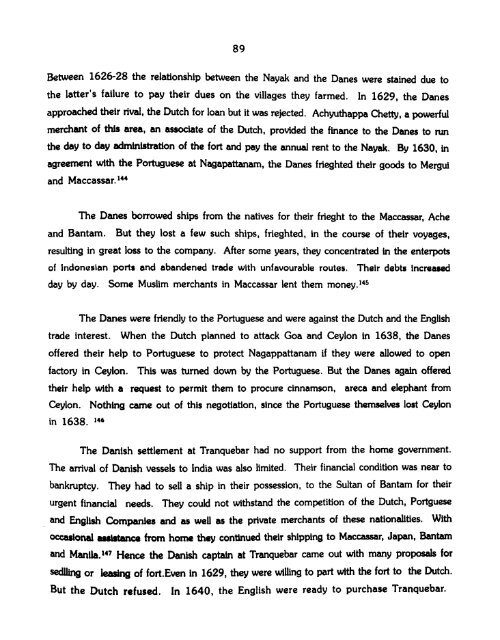maritime activities economy and social customs of the muslims of ...
maritime activities economy and social customs of the muslims of ...
maritime activities economy and social customs of the muslims of ...
You also want an ePaper? Increase the reach of your titles
YUMPU automatically turns print PDFs into web optimized ePapers that Google loves.
Between 1626-28 <strong>the</strong> relationship between <strong>the</strong> Nayak <strong>and</strong> <strong>the</strong> Danes were stained due to<br />
<strong>the</strong> latter's failure to pay <strong>the</strong>ir dues on <strong>the</strong> villages <strong>the</strong>y farmed. In 1629, <strong>the</strong> Danes<br />
approached <strong>the</strong>ir rival, <strong>the</strong> Dutch for loan but it was rejected. Achyuthappa Chetty, a powerful<br />
merchant <strong>of</strong> this area, an associate <strong>of</strong> <strong>the</strong> Dutch, provided <strong>the</strong> finance to <strong>the</strong> Danes to run<br />
<strong>the</strong> day to day administmtion <strong>of</strong> <strong>the</strong> fort <strong>and</strong> pay <strong>the</strong> annual rent to <strong>the</strong> Nayak. By 1630, in<br />
agreement with <strong>the</strong> Portuguese at Nagapattanam, <strong>the</strong> Danes frieghted <strong>the</strong>ir goods to Mergui<br />
<strong>and</strong> Maccassar."'<br />
The Danes borrowed ships from <strong>the</strong> natives for <strong>the</strong>ir frieght to <strong>the</strong> Maccassar, Ache<br />
<strong>and</strong> Bantam. But <strong>the</strong>y lost a few such ships, frieghted, in <strong>the</strong> course <strong>of</strong> <strong>the</strong>ir voyages,<br />
resulting in great loss to <strong>the</strong> company. After some years, <strong>the</strong>y concentrated in <strong>the</strong> enterpots<br />
<strong>of</strong> lndoncslan ports <strong>and</strong> ab<strong>and</strong>oned trade with unfavourabie routes. Their debts increased<br />
day by day. Some Muslim merchants in Maccassar lent <strong>the</strong>m money.145<br />
The Danes were friendly to <strong>the</strong> Portuguese <strong>and</strong> were against <strong>the</strong> Dutch <strong>and</strong> <strong>the</strong> English<br />
trade interest. When <strong>the</strong> Dutch planned to attack Goa <strong>and</strong> Ceylon in 1638, <strong>the</strong> Danes<br />
<strong>of</strong>fered <strong>the</strong>ir help to Portuguese to protect Nagappattanam if <strong>the</strong>y were allowed to open<br />
factory in Ceylon. This was turned down by <strong>the</strong> Portuguese. But <strong>the</strong> Danes again <strong>of</strong>fered<br />
<strong>the</strong>ir help with a request to permit <strong>the</strong>m to procure cinnamson, areca <strong>and</strong> elephant from<br />
Ceylon. Nothing m e out <strong>of</strong> this negotiation, since <strong>the</strong> Portuguese <strong>the</strong>mselves lost Ceylon<br />
in 1638.<br />
The Danish settlement at Tranquebar had no support from <strong>the</strong> home government.<br />
The arrival <strong>of</strong> Danish vessels to India was also limited. Their financial condition was near to<br />
bankruptcy. They had to sell a ship in <strong>the</strong>ir possession, to <strong>the</strong> Sultan <strong>of</strong> Bantam for <strong>the</strong>ir<br />
urgent financial needs. They could not withst<strong>and</strong> <strong>the</strong> competition <strong>of</strong> <strong>the</strong> Dutch, Portguese<br />
<strong>and</strong> English Cornpanlea <strong>and</strong> as well as <strong>the</strong> private merchants <strong>of</strong> <strong>the</strong>se nationalities. With<br />
occarional aulrtanco from home <strong>the</strong>y continued <strong>the</strong>ir shipping to Maccassar, Japan, Bantam<br />
<strong>and</strong> Manila."' Hence <strong>the</strong> Danish captain at Tranquebar came out with many proposals for<br />
sedlling or k&ng <strong>of</strong> fort.Even in 1629, <strong>the</strong>y were willing to part with <strong>the</strong> fort to <strong>the</strong> Dutch.<br />
But <strong>the</strong> Dutch refused. In 1640, <strong>the</strong> English were ready to purchase Tranquebar.

















